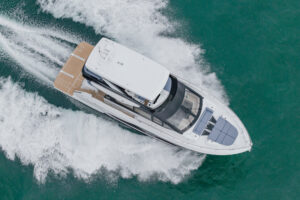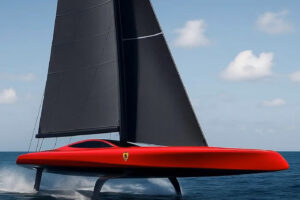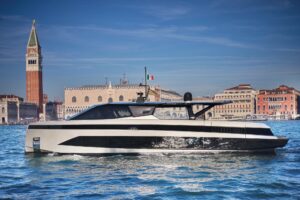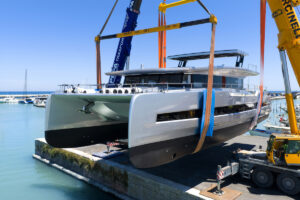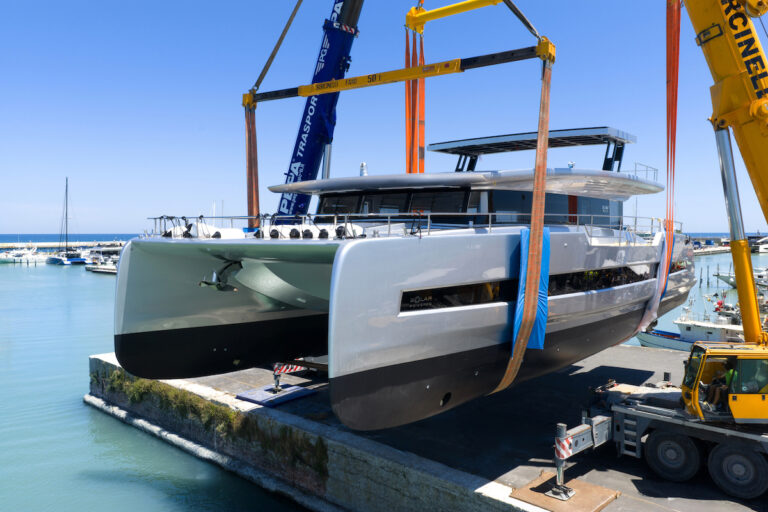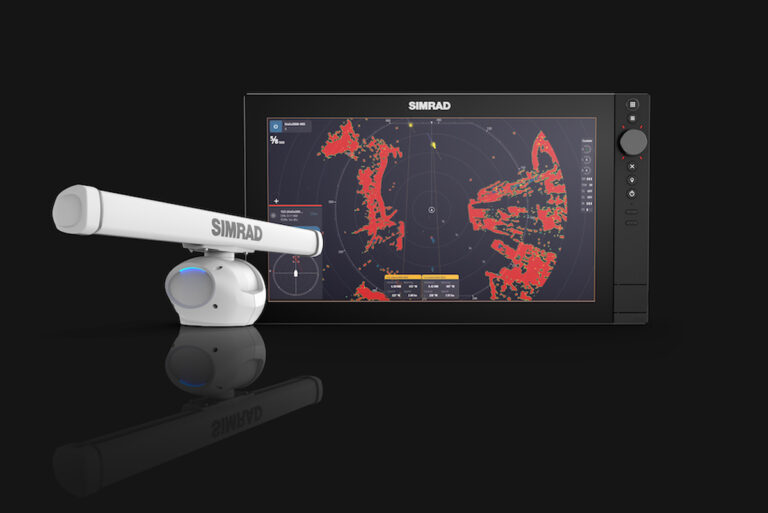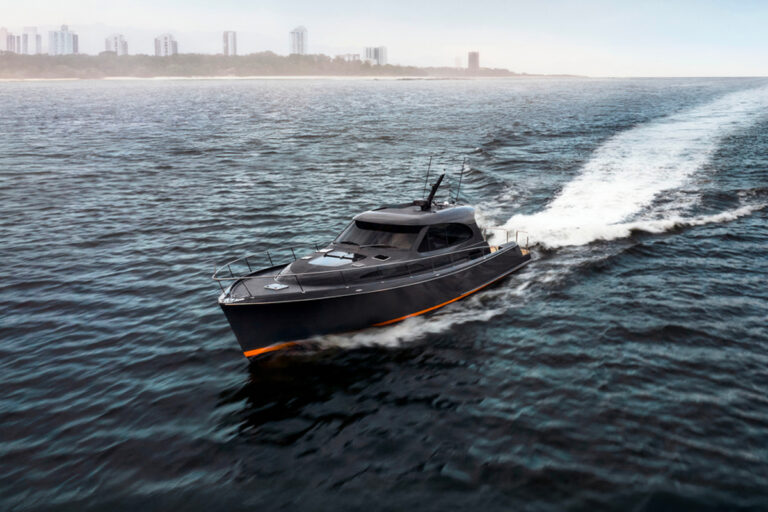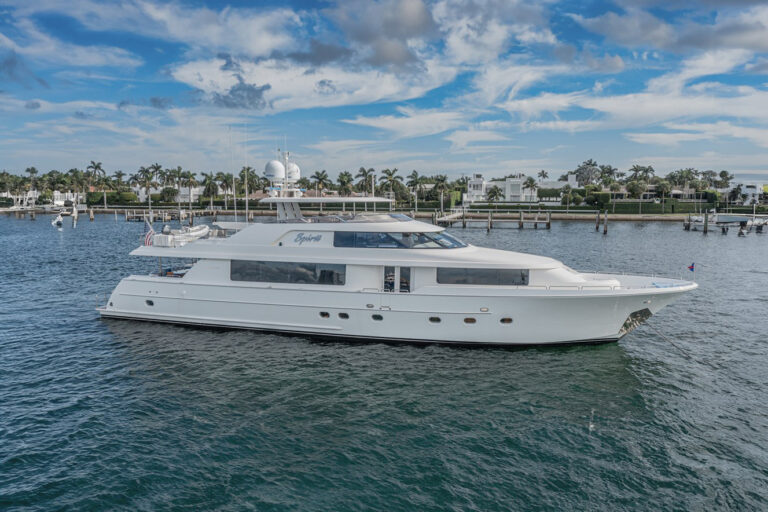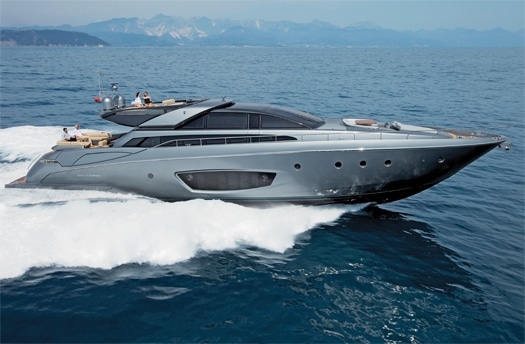
ytgnov17riva525.jpg
I’ve confessed it before, and I’ll admit my weakness again: I love classic mahogany Riva speedboats. Aquarama, Tritone, Junior, it doesn’t matter, I love ’em all. As a result, I tend to review each new Riva model with great expectations and, at the same time, a rather high bar to clear. The Domino, a new 86-foot speedster, doesn’t disappoint.
A year ago, we brought you news of the then-latest Riva yacht, the 92- foot Duchessa (“Hold That Lineage!,” December 2008). You might wonder why Riva would introduce another new model so soon and so close in length, but these are two entirely different animals. The Duchessa was a large yacht made smaller, a downsized but still very luxurious offshoot of Riva’s voluminous flagship, the 115-foot Athena.
The Domino, by contrast, is an upscale version of a smaller boat, owing much of her inspiration to the 63-foot Vertigo and 68-foot Ego models. Her profile is low and sleek, reminiscent of earlier Riva sportboats, and her beam is nearly two feet less than that of the Duchessa. As any designer will tell you, that difference means less volume and weight, a higher length-beam ratio, and the expectation of better performance. The Domino delivers in spades, reaching a top speed of 38 knots and doing it with very little fuss. She is a luxurious yacht, to be sure, but is considerably closer to her mahogany speedboat roots than her larger sisters.

| | |
The Domino incorporates a disappearing aft bulkhead found on many of the smaller Riva dayboats, enabling her guests to enjoy the feeling of an open boat when the weather is cooperative. There’s a difference, though, that is not apparent upon first glance at her exterior. This is not a hardtop sport cruiser, but rather, she has a full flying bridge worked into her low profile. As a result, there is no opening panel in her hardtop above the salon, as on smaller Rivas. Instead, a fixed glass panel forward of the flying bridge brings lots of light into the dining area and lower helm, and is fitted with a sliding shade to block the sun’s rays when desired.
It’s a nice compromise that enables the Domino to retain a sporty, open feeling below while still providing the amenities of a flying bridge, with three helm seats and a large sunpad. The helm station forward starts out low and then folds down when not in use to lower the profile even further. Consistent with this theme, there is no windshield on this first hull, but Riva tells me one is being considered as an option on future Dominos. In consideration of this styling emphasis, the side rails around the flying bridge are fairly low, and nonexistent forward and aft, so a bit of care is in order for topside guests while underway.
The railing situation is better on the main deck, where a second sunpad is located on the foredeck, well protected by bulwarks and sturdy rails at the sides. Grab rails also surround the comfy six-place dinette that lies between the sunpad and the pilothouse windshield. Aft, there are safety gates to either side of a spacious U-shaped sitting area, which can be open or shaded at will, thanks to a retractable awning that extends from the back of the flying bridge.
The gates guard steps that lead down to the integral swim platform. A retractable passerelle extends up to 14 feet for access to the aft deck when stern-moored. Between the steps, an opening transom lifts to reveal a garage for storing a RIB and a personal watercraft.
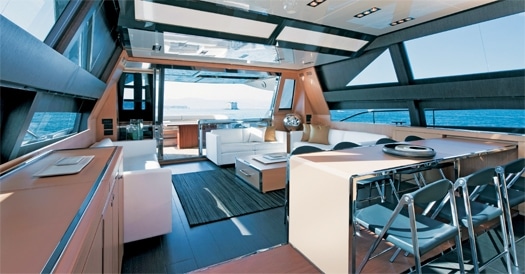
| | |
The deckhouse is essentially one large space, and when the aft bulkhead is fully open, it creates a rather magnificent space for entertaining, whether underway, on the hook, or dockside. In addition to the sitting area at the transom, there’s also a dinette for six on the aft deck. Should you prefer to dine inside, a table for eight guests slides out of the port houseside between the salon and pilothouse. Salon seating includes two double sofas and one triple, all in white leather. A 46-inch TV and a CD/DVD/MP3 system with an iPod docking station links to speakers in the salon, pilothouse, aft deck, and flying bridge. One of my favorite features of the salon and dining area is the double row of windows. The upper section allows a great view when standing and the lower section when seated.
Forward, the pilothouse is shielded from the salon and dining area by a partial-width centerline bulkhead that incorporates stowage on the aft side below the mirrored TV. Three helm seats are located on the forward side. These are fixed in position on hull number one, but future builds will include adjustable mounts for flexibility and improved comfort at the wheel. Sightlines from the helm are great looking forward, and by taking a step or two to either side, the salon windows and glass aft bulkhead allow the helmsman an excellent view all around. If that’s not enough, doors to either side of the helm provide access to side decks that run the length of the Domino.

| | |
From the pilothouse, stairs to port lead down to the galley. A single opening port provides light and air to this compact but well-equipped space. To the starboard side of the pilothouse is another staircase, this one leading to the guest accommodations. Directly off the lower guest foyer is a day-head with shower that also serves as the head for the starboard stateroom, which is fitted with twin berths.
A second stateroom to port also has twin berths, but one can be relocated to create a queen berth when desired. This stateroom also has a larger head, which allows room for a bidet in addition to the toilet, lavatory, and shower. At the bow is a VIP stateroom with an island queen berth. This stateroom also has a fully outfitted head, as well as twin hanging lockers. Overhead, a hatch opens to the foredeck for light, air, and emergency escape.
Aft of the twin cabins and down a few more steps is the full-beam master suite, located amidships for maximum comfort at sea. Large hullside windows, apparent in the Domino’s profile, extend nearly the length of the stateroom port and starboard. They provide an unparalleled view, whether from the queen berth fitted to port or from the leather sofa and armchair in the spacious sitting area to starboard. A 32-inch TV, again hidden in a mirror, faces the berth from the forward bulkhead.
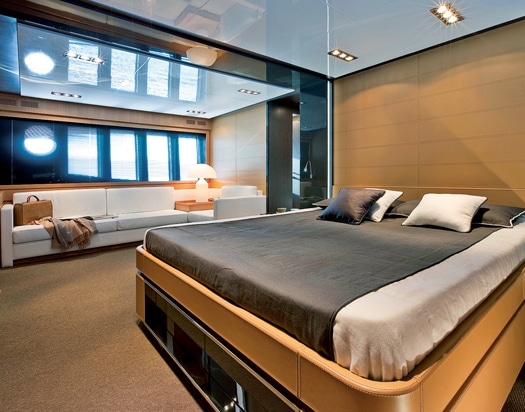
| | |
The Domino is in that magic size range that would allow for owner operation, but should crew be preferred, quarters are located between the owner’s stateroom and the aft engineroom, with private access via a protected stair from the aft deck. The space includes two twin-berth staterooms, one small head with shower, a compact crew mess, and a washer/dryer.
From the crew quarters, a watertight door provides quick and easy access to the engineroom, home to the pair of 2,400-horsepower MTU diesels that power the Domino to a top speed of 38 knots. This is at a partial fuel load, and Riva is one of the few builders who actually provide data in their published specifications for predicting speeds at other loadings. In the case of the Domino, a knot is lost for each additional 2,650 pounds of displacement. Perhaps if other builders were as candid, their owners would be more careful about taking so much unnecessary gear along for the ride.
The Domino is a great interim step between Riva’s range of smaller dayboats and their big motoryachts. It retains much of the Riva runabout spirit while providing a lot more capability than a smaller hardtop cruiser. If you want a bit more in the way of creature comforts but aren’t yet ready to give up the sporting life, the Domino may just be the lady for you.
Allied Marine Group, (954)462-5527; **www.alliedmarine.com**

